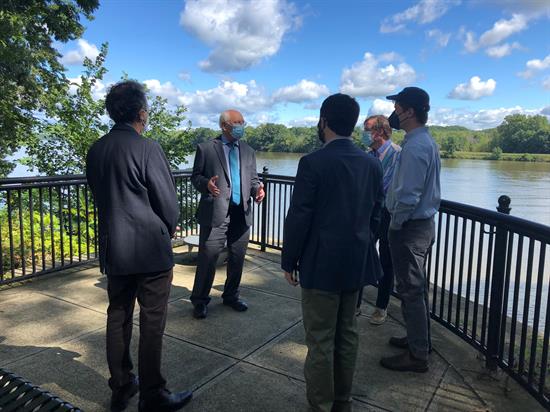- Home
- About
-
Constituent Services
- Academy Nominations
- Community Project Funding
- Congressional Art Competition
- Congressional App Challenge
- Congressional Commendation
- Event Invitation
- Grants
- Help with a Federal Agency
- Internships
- IRA Clean Energy Consumer Benefits
- Know Your Rights: Immigration
- Request a Meeting
- Request Surplus Books
- Presidential Greeting
- Visit Washington D.C.
- Issues & Legislation
- News
- 20th District
- Contact

Opinion Pieces
Heritage Areas face looming cliff – our bill protects these cherished sites
Washington,
December 16, 2021
If you recently visited a local historic site, shopped at a small business, or attended a community event, your local National Heritage Area may have made that experience possible. Heritage Areas connect us with the diverse history of our regions while fueling hundreds of local economies across the nation. Despite their economic, environmental, and cultural value, without urgent action, our heritage areas face an uncertain future. What is a National Heritage Area? President Reagan created “a new kind of national park” when he signed legislation in 1984 to establish the first National Heritage Area—which, in many ways, was no park at all. Rather than an enclosed scenic landscape, the former president envisioned community-led National Heritage Areas as lived-in spaces that unite heritage celebration, recreation, and economic development. Congress has since created another 54 Heritage Areas—spanning 34 states, nearly 600 counties, and countless American stories—that live up to this vision. From the battlefields of the American Revolution to the swamps of the Atchafalaya Basin, the Civil War to Civil Rights, and the Motor City to mining towns, Heritage Areas instill in us a sense of place and link us with the voices of our past. NHAs boost local economies As co-chairs of the Congressional National Heritage Area Caucus, we are committed to preserving these sites because they give the communities around them so much back in return—billions of dollars in tourism spending, thousands of jobs, cleaner air and water, educational programming, and support for local projects. This is achieved through local efforts that use less than one percent of the National Parks Service budget and have no effect on private property rights. Unlike National Parks, Heritage Areas are managed through public-private partnerships that match an average of $5.50 for every $1 in federal funding—a healthy return on investment for the American taxpayer. These partnerships also work hand-in-hand with programs such as the Historic Preservation Tax Credits to further incentivize revitalization and redevelopment. In total, Heritage Areas have a nearly $13 billion annual economic impact and support almost 150,000 jobs nationwide. We have seen firsthand the remarkable strengths heritage areas bring to our home districts and communities across the nation. In West Virginia, the Wheeling National Heritage Area launched a program to redevelop the riverfront, celebrating the City of Wheeling’s connection to the Ohio River and its many benefits to the local economy. During the pandemic, the program delivered thousands of dollars to help 48 struggling local businesses keep their doors open. New York’s Maurice D. Hinchey Hudson River Valley National Heritage Area hosts an annual festival with more than 200 local events that generates an estimated $20 million economic impact. In the nearby Erie Canalway National Heritage Corridor, visitors from 25 states walked, ran, cycled, and paddled nearly 240,000 miles this past year to experience the canals that transformed America and bring tourism dollars to historic canal towns. NHAs face a looming funding cliff Despite their popularity and critical work, existing and future NHAs face ongoing uncertainty. Currently, each Heritage Area relies on an individual, biennial congressional reauthorization process that frequently puts their federal funding at risk. Every two years, each Heritage Area must expend significant resources pursuing funding extensions and reauthorizations, often through last-minute congressional action. For example, earlier this month, Congress passed legislation to extend funding through February 2022 for 30 expiring NHAs, a short-term fix that leaves the affected sites uncertain about their futures. This stop-gap model puts significant pressure on the local administrators that run these sites, diverting time and resources away from their important work. We need the National Heritage Area Act Our bipartisan legislation, the National Heritage Area Act, will finally bring long-term stability to these sites, allowing them to continue to serve their communities and strengthen surrounding economies with minimal federal support. The National Heritage Area Act would end the current system of piecemeal reauthorizations through a 15-year authorization for all existing NHAs, establish the first-ever standardized criteria for designating new NHAs, and strengthen accountability by creating an evaluation process for existing sites. Congress has the power to ensure our historic sites can be enjoyed for generations to come by making our National Heritage Area Act law. Until then, we risk losing our Heritage Areas—and our shared history they encapsulate—forever. Our hope is that a constant uncertainty is replaced with a standardized process that gives Heritage Areas peace of mind and ensures that Americans from all walks of life can continue to experience these national treasures. |
